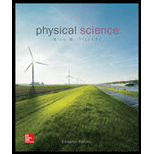
Physical Science
11th Edition
ISBN: 9780077862626
Author: Bill Tillery, Stephanie J. Slater, Timothy F. Slater
Publisher: McGraw-Hill Education
expand_more
expand_more
format_list_bulleted
Concept explainers
Textbook Question
Chapter 20, Problem 36AC
Crushing of rock at a quarry to make smaller-sized gravel is an example of
a. physical weathering.
b. chemical weathering.
c. mechanical weathering.
d. reduction weathering.
Expert Solution & Answer
Want to see the full answer?
Check out a sample textbook solution
Students have asked these similar questions
b. Under what condition is a material or a rock mass considered to:
i. Have positive Poisson’s ratio
ii. Have negative Poisson’s ratio
iii. Possess planar discontinuity
iv. Exhibit positive deformation
v. Exhibit negative deformation?
True or False
1. If a well is drilled into a confined aquifer, the water can rise above its level in the aquifer because of the extra hydrostatic (fluid) pressure; which is called an artesian system. The water in an artesian system will rise all the way to the ground surface.
2. In areas suffered from surface subsidence, solutions such as pumping water back underground are likely to work.
d) Describe how porosity and permeability are associated with one another.
Chapter 20 Solutions
Physical Science
Ch. 20 -
1. Small changes that result in the breaking up,...Ch. 20 -
2. The process of physically removing weathered...Ch. 20 -
3. Muddy water rushing downstream after a heavy...Ch. 20 -
4. The physical breakup of rocks without any...Ch. 20 -
5. Chemical weathering, the dissolving or...Ch. 20 -
6. The process of peeling off layers of rock,...Ch. 20 -
7. The weak acid formed by the reaction of water...Ch. 20 -
8. A mixture of unconsolidated weathered earth...Ch. 20 -
9. Decay-resistant, altered organic material...Ch. 20 -
10. Two minerals that usually remain after...
Ch. 20 -
11. Weathered materials move to lower elevations...Ch. 20 -
12. The slow movement downhill of soil on the...Ch. 20 -
13. The wide, level floor of a valley built by a...Ch. 20 -
14. The deposit at the mouth of a river where...Ch. 20 -
15. Rock fragments frozen in moving glacier ice...Ch. 20 -
16. The agent that has the least ability to...Ch. 20 - Prob. 17ACCh. 20 - Prob. 18ACCh. 20 -
19. What is the pH of natural rainwater?
a. 5.0...Ch. 20 -
20. Freezing water exerts pressure on the wall...Ch. 20 -
21. Of the following rock weathering events, the...Ch. 20 -
22. Which of the following would have the...Ch. 20 -
23. Broad meanders on a very wide, gently sloping...Ch. 20 - Prob. 24ACCh. 20 -
25. A likely source of loess is
a. rock...Ch. 20 -
26. The landscape in a dry climate tends to be...Ch. 20 -
27. Peneplains and monadnocks are prevented from...Ch. 20 -
28. The phrase weathering of rocks means
a. able...Ch. 20 -
29. What are you doing to a rock if you pick up...Ch. 20 -
30. What are you doing to the fragments of a...Ch. 20 -
31. What are you doing to a rock if you dissolve...Ch. 20 - Prob. 32ACCh. 20 -
33. The soil called loam is
a. all sand and...Ch. 20 -
34. A moraine is a
a. wind deposit.
b. glacier...Ch. 20 -
35. The breaking up, crumbling, chemical...Ch. 20 -
36. Crushing of rock at a quarry to make...Ch. 20 -
37. Fragments of rocks fall into a mountain...Ch. 20 -
38. Tree roots grow and expand, and eventually...Ch. 20 -
39. Damage to the Lincoln Memorial by rain and...Ch. 20 -
40. Ferromagnesian minerals will react with...Ch. 20 -
41. You are planning a garden and need a soil...Ch. 20 -
42. The formation of a shallow layer of water by...Ch. 20 -
43. The most extensive glaciers in the United...Ch. 20 -
44. Continental glaciers are found...Ch. 20 -
45. An example of a chemical weathering process...Ch. 20 - Prob. 1QFTCh. 20 -
2. Granite is the most common rock found on...Ch. 20 -
3. What other erosion processes are important as...Ch. 20 -
4. Describe three ways in which a river erodes...Ch. 20 - Prob. 5QFTCh. 20 - Prob. 6QFTCh. 20 -
7. What is a glacier? How does a glacier erode...Ch. 20 -
8. What is rock flour and how is it produced?
Ch. 20 -
9. Could a glacier erode the land lower than sea...Ch. 20 -
10. Explain why glacial erosion produces a...Ch. 20 - Prob. 11QFTCh. 20 - Prob. 12QFTCh. 20 -
13. What essential condition must be met before...Ch. 20 -
14. Compare the features caused by stream...Ch. 20 -
15. Compare the materials deposited by streams,...Ch. 20 -
16. Why do certain stone buildings tend to...Ch. 20 - Prob. 17QFTCh. 20 -
18. Discuss all the reasons you can in favor of...Ch. 20 - Prob. 1FFACh. 20 -
2. Speculate whether the continents will ever be...Ch. 20 - Prob. 3FFACh. 20 - Prob. 1PEBCh. 20 -
2. The average rate of chemical weathering of...Ch. 20 -
3. A slope is creeping at a rate of 1.2 mm/yr. A...Ch. 20 - Prob. 4PEBCh. 20 - Prob. 5PEBCh. 20 - Prob. 6PEBCh. 20 -
7. The elevation of a streambed is surveyed near...Ch. 20 -
8. Each year, sheet erosion removes 0.9 mm of...Ch. 20 - Prob. 9PEBCh. 20 - Prob. 10PEBCh. 20 -
11. The discharge (Q) of a stream is the velocity...Ch. 20 -
12. What is the velocity (v) of a stream with a...Ch. 20 - Prob. 13PEBCh. 20 -
14. A 1998 survey of glacial end moraines...Ch. 20 -
15. Rates of tectonic uplift can be determined...
Additional Science Textbook Solutions
Find more solutions based on key concepts
What discovery in the 15th century greatly advanced progress in science?
Conceptual Physical Science Explorations
An aluminum calorimeter with a mass of 100 g contains 250 g of water. The calorimeter and water are in thermal ...
Physics for Scientists and Engineers
21.35 (a) An electron is moving east in a uniform electric field of 1.50 N/C directed to the west. At point A. ...
University Physics with Modern Physics (14th Edition)
1. Rub your hands together vigorously. What happens? Discuss the energy transfers and transformations that take...
College Physics: A Strategic Approach (4th Edition)
Choose the best answer to each of the following. Explain your reasoning. If Earth were twice as far as it actua...
The Cosmic Perspective Fundamentals (2nd Edition)
Knowledge Booster
Learn more about
Need a deep-dive on the concept behind this application? Look no further. Learn more about this topic, physics and related others by exploring similar questions and additional content below.Similar questions
- 12. Which part of the earth makes up about one-third of earth’s total mass and is mostly iron witha solid part and a part that acts like a liquid?A. mantle B. core C. crust D. asthenospherearrow_forward(c) A trapezoidal channel with bottom width 3 m and side slopes 5(H): 2(V) conveys 8 m³/s of flow. The channel rests on 0.32° ground surface lined with concrete at bottom and dressed stone in mortar on both sides (TABLE Q2(c)). If a 0.5 m-high weir is placed across the channel section, determine depth of flow above the weir.arrow_forward
Recommended textbooks for you
 An Introduction to Physical SciencePhysicsISBN:9781305079137Author:James Shipman, Jerry D. Wilson, Charles A. Higgins, Omar TorresPublisher:Cengage Learning
An Introduction to Physical SciencePhysicsISBN:9781305079137Author:James Shipman, Jerry D. Wilson, Charles A. Higgins, Omar TorresPublisher:Cengage Learning

An Introduction to Physical Science
Physics
ISBN:9781305079137
Author:James Shipman, Jerry D. Wilson, Charles A. Higgins, Omar Torres
Publisher:Cengage Learning
A Level Physics – Ideal Gas Equation; Author: Atomi;https://www.youtube.com/watch?v=k0EFrmah7h0;License: Standard YouTube License, CC-BY